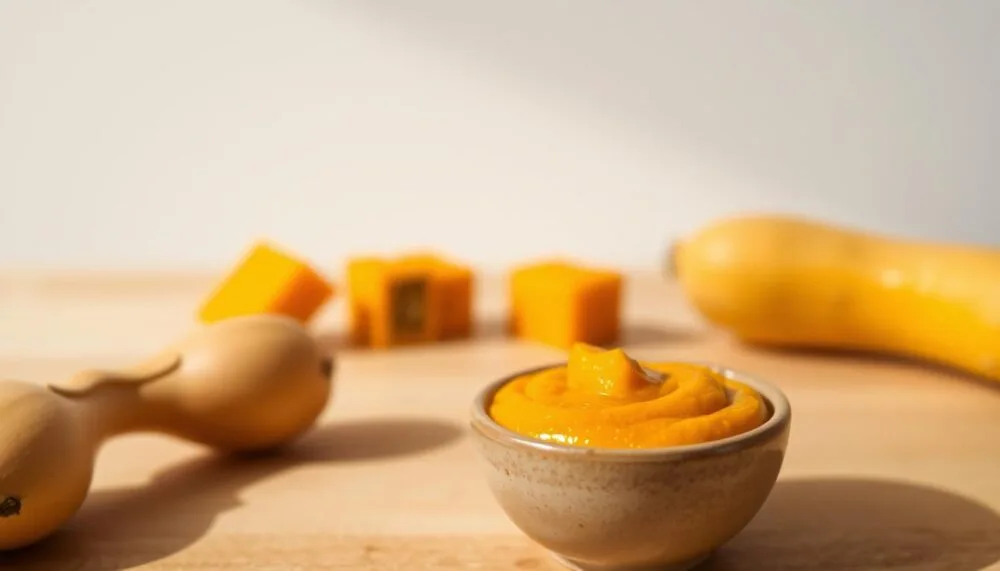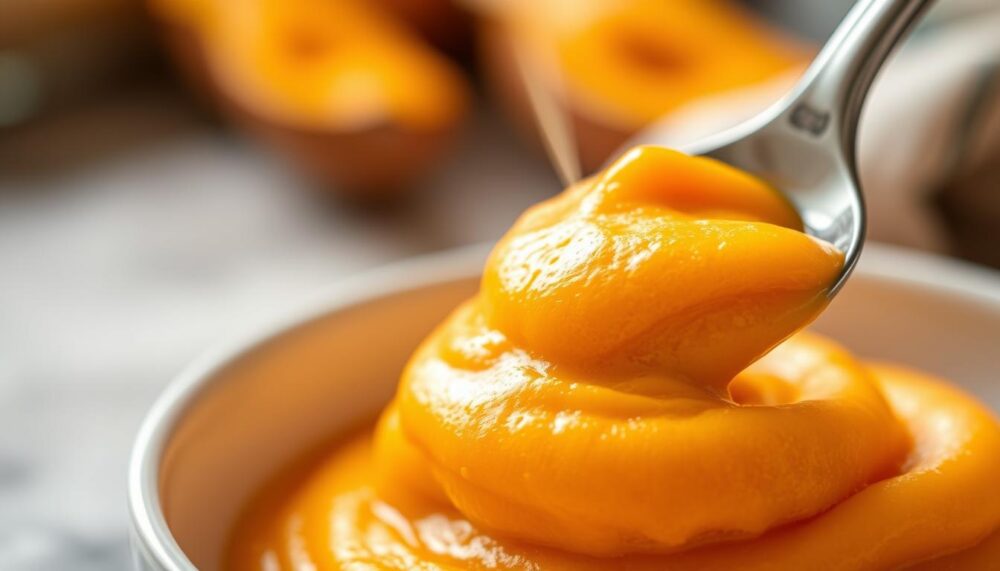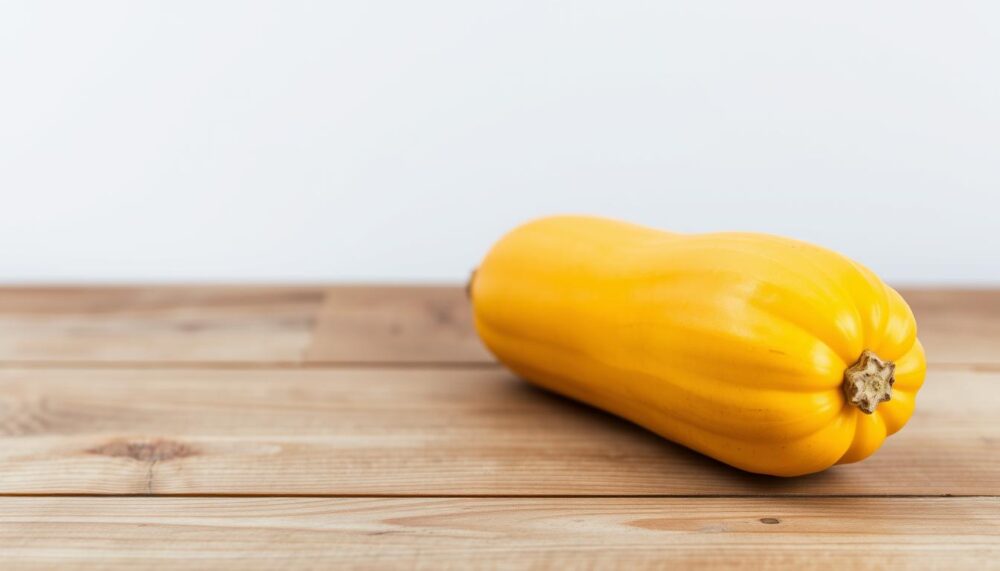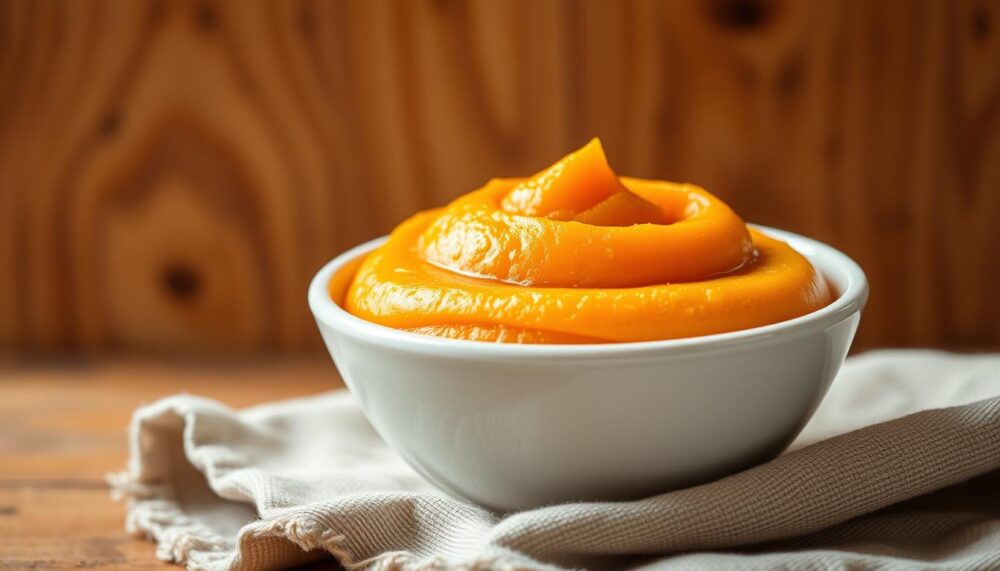
Welcome to our guide on cooking butternut squash for baby food. This vegetable is both nutritious and tasty, making it perfect for your baby’s meals. We’ll show you how to pick the right squash and cook it, so you can make a healthy dish for your little one.
It’s simple to learn how to cook butternut squash for your baby. This guide will help you make a yummy and healthy meal for your baby. It’s great for both new and experienced parents, giving you the confidence to cook for your baby.
In this article, we’ll share our knowledge on cooking butternut squash for baby food. We’ll cover choosing the right squash, different cooking methods, and how to store it. This will help you make a delicious and healthy meal for your baby.
Key Takeaways
- Butternut squash is a nutritious and delicious vegetable for baby food
- Learning how to cook butternut squash for baby food is easy and straightforward
- Selecting the perfect squash is crucial for a healthy butternut squash baby food recipe
- Cooking methods, such as steaming and roasting, can help preserve nutrients
- Proper storage guidelines can help keep your butternut squash baby food fresh
- A healthy butternut squash baby food recipe can be a great addition to your baby’s diet
- Cooking butternut squash for baby food can be a fun and rewarding experience
Benefits of Butternut Squash for Your Baby’s Development
As a parent, I always look for foods rich in nutrients for my baby. Butternut squash is a top pick. It’s full of vitamins A, C, and potassium, making it perfect for homemade baby puree. It’s also great for beginners.
Butternut squash is tasty and full of fiber. This helps with digestion and prevents constipation. It also has antioxidants that protect my baby’s cells. So, I feel good about adding it to my baby’s meals.

- Supporting healthy digestion and preventing constipation
- Providing essential vitamins and minerals, such as vitamin A and potassium
- Offering antioxidant properties to protect my baby’s cells from damage
Adding butternut squash to my baby’s diet makes me confident. It’s healthy and tastes great. It’s a fantastic choice for any baby food, whether homemade or beginner-friendly.
When Can Babies Start Eating Butternut Squash
Introducing new foods to your baby can be scary. Butternut squash is a great choice, but you need to know when to start. Babies can usually eat butternut squash around 6 months old, if it’s cooked and pureed right. Always check with your pediatrician before adding new foods.
Start with small amounts of butternut squash to ease your baby into it. This helps them get used to the taste and texture. You can mix easy butternut squash baby food with breast milk or formula. Here are some tips:
- Start with a single-ingredient puree to monitor for any signs of allergy or intolerance.
- Gradually introduce new ingredients and flavors to keep mealtime interesting and prevent boredom.
- Consider making butternut squash baby food ideas like mixing it with apples or pears for a sweet and nutritious treat.
Always put your baby’s health first when trying new foods. With patience and creativity, you can make tasty and healthy
Selecting the Perfect Butternut Squash for Baby Food
Choosing the right squash is key for nutritious butternut squash baby food. A fresh, healthy squash is the starting point. Look for a hard, matte skin and a sweet, nutty smell.

Ripeness Indicators and Quality Considerations
A uniform beige color is what you want. Avoid soft spots or bruises. A smaller squash, about 2-3 pounds, is best for easy handling and cooking.
Organic vs. Conventional Options
Organic squash is a better choice for your baby. It’s grown without harmful chemicals. This makes it a healthier option for your baby’s meals.
Choosing a high-quality, ripe squash is crucial. It ensures your baby gets a delicious, healthy meal. Always put your baby’s health and nutrition first when making their food.
Essential Tools and Equipment Needed
To make healthy butternut squash baby food, you need some key tools. As a parent, having the right equipment is important. It ensures your baby’s food is both nutritious and safe.
A steamer is essential for cooking butternut squash. It keeps the nutrients and flavor in. You’ll also need a blender or food processor to make the squash smooth. Don’t forget storage containers for keeping the food fresh.
Here are some other tools you’ll need:
- A large pot for boiling or steaming
- A cutting board and knife for preparing the squash
- A spoon and spatula for scooping and stirring
- A freezer-safe container for storing frozen baby food

With these tools, you can make tasty and healthy butternut squash baby food. Always put your baby’s safety and health first. If you have questions, talk to your pediatrician.
How to Cook Butternut Squash for Baby Food
Cooking butternut squash for baby food is easy. First, pick a method that keeps the squash’s nutrients and taste. There are a few ways to how to cook butternut squash for baby food.
A butternut squash baby food recipe can be simple. You can steam, roast, or boil the squash. Here’s how to do each:
- Steaming: Place the squash in a steamer basket and steam for 10-15 minutes, or until tender.
- Roasting: Preheat the oven to 400°F (200°C), then roast the squash for 30-40 minutes, or until tender.
- Boiling: Place the squash in a pot of boiling water and cook for 10-15 minutes, or until tender.
After cooking, puree the squash in a blender or food processor. This makes it smooth and creamy. You can add water or breast milk to thin it out if needed. These steps help you make a tasty and healthy butternut squash baby food recipe for your baby.
When cooking butternut squash for baby food, safety is key. Always wash your hands before touching the squash. Cook it to the right temperature to avoid illness. By being careful and following a simple butternut squash baby food recipe, you can give your baby a nutritious and yummy meal.
Preparing and Pureeing Your Squash
After cooking your butternut squash, it’s time to puree it for your baby. To make a tasty homemade butternut squash baby puree, you need the right texture. Use a food processor or blender to make it smooth and creamy.
For beginner-friendly butternut squash baby food, start with just one ingredient. This lets your baby get used to the taste and texture. Then, you can mix in other ingredients for different flavors.
Here are some tips for preparing and pureeing your squash:
- Use a high-quality food processor or blender for a smooth puree.
- Add a little water or breast milk to get the right consistency.
- Strain the puree through a fine-mesh sieve to remove fibers or pulp.
By following these steps, you can make a yummy and healthy homemade butternut squash baby puree. Always check the puree’s temperature before serving it. Also, store leftovers in the fridge or freezer for later.
Storage Guidelines and Tips
Storing butternut squash baby food right is key to keeping it fresh and safe. As a parent, you want your easy butternut squash baby food to stay good for your baby. To do this, following the right storage tips is important.
There are a few ways to store butternut squash baby food ideas. Here are some options:
- Refrigeration: Store cooked and pureed butternut squash in airtight containers in the refrigerator for up to 3 days.
- Freezing: Freeze cooked and pureed butternut squash in ice cube trays or airtight containers for up to 3 months.
- Thawing: Thaw frozen butternut squash cubes or containers overnight in the refrigerator or quickly by submerging them in cold water.
Always check for spoilage signs before serving butternut squash baby food. If it smells bad, looks slimy, or has mold, throw it away.
By following these storage tips, your easy butternut squash baby food will stay fresh and safe for your baby. Always put your baby’s health and safety first when preparing and storing their food.
Safety Precautions and Best Practices
When making nutritious butternut squash baby food, it’s key to follow safety steps. This ensures your baby stays healthy. Always wash your hands well before and after touching the squash.
To keep the simple butternut squash baby food recipe safe, clean all tools and areas. Here are some important safety tips:
- Always check the squash for any signs of spoilage or mold before using it.
- Use a clean and sanitized environment when preparing the squash.
- Avoid cross-contamination by separating the squash from other foods.
By sticking to these safety steps, your baby can enjoy nutritious butternut squash baby food safely. Always put your baby’s health first when making their food. If you’re unsure, talk to your pediatrician.
Combining Butternut Squash with Other Baby Foods
As a parent, I’m always on the lookout for tasty and healthy meals for my baby. Healthy butternut squash baby food is great because it can be mixed with other foods. This creates a variety of flavors and textures. Learning how to cook butternut squash for baby food opened up a world of possibilities for me.
Butternut squash goes well with fruits like apples, pears, and peaches. You can also mix it with veggies like sweet potatoes or carrots. Adding chicken or turkey gives it extra protein. The goal is to find mixes your baby likes and that are full of nutrients.
- Butternut squash and apple puree
- Butternut squash and chicken mix-in
- Butternut squash and sweet potato mash
These mixes are not just yummy, but also full of good stuff for your baby’s growth. By being creative with healthy butternut squash baby food and learning how to cook butternut squash for baby food, you can offer your baby many tasty and healthy meals.
Troubleshooting Common Issues
When making a butternut squash baby food recipe, you might run into some common problems. One big issue is the texture of the homemade butternut squash baby puree. If it’s too thick, adding a bit of water can help. If it’s too thin, cooking it a bit longer can thicken it up.
Another problem is the consistency of the puree. If it’s not smooth, blending it in a blender or food processor can help. You can also mix in fruits or veggies to make it more interesting and nutritious.
- Stringy texture: Try cooking the squash for a longer time or using a different cooking method.
- Bitter taste: Use a sweeter variety of squash or add a small amount of fruit puree to balance the flavor.
- Too much liquid: Cook the squash for a few more minutes or add a thickening agent, such as oatmeal or cereal.
By following these tips, you can make a tasty and healthy butternut squash baby food recipe. Always check the food’s temperature and texture before serving it to your baby. And don’t forget to talk to your pediatrician if you have any worries.
Signs Your Baby Enjoys Butternut Squash
As a parent, watching your baby’s reactions to new foods is key. This includes beginner-friendly butternut squash baby food. Look for signs they like it, like leaning in, opening their mouth, and swallowing.
It’s normal for babies to make faces or spit out new foods. It doesn’t always mean they don’t like it. It might just mean they’re getting used to the taste and feel. Here are signs your baby might enjoy butternut squash:
- They show interest in the food and try to grab the spoon or bottle.
- They make happy sounds or coo while eating.
- They finish the serving and seem satisfied.
Introducing beginner-friendly butternut squash baby food and easy butternut squash baby food can help your baby develop good eating habits. It can also help them love healthy foods. Always talk to your pediatrician before adding new foods to your baby’s diet.
Conclusion
Adding butternut squash to your baby’s meals is a great way to boost their nutrition. This guide shows you how to make tasty and nutritious butternut squash baby food. Your baby will love it.
Always check with your pediatrician before trying new foods. They can help you make sure your baby is getting the best. This way, you can cook healthy meals that your child will enjoy.
Bon appétit, and happy feeding!
FAQ
What are the benefits of butternut squash for my baby’s development?
Butternut squash is packed with vitamins A, C, and potassium. It’s also full of fiber, which aids digestion and prevents constipation. Plus, it has antioxidants that protect your baby’s cells.
When can I start introducing butternut squash to my baby’s diet?
You can introduce butternut squash to your baby’s diet at 6 months. Make sure it’s cooked and pureed first. Always check with your pediatrician before adding new foods.
How do I select the perfect butternut squash for baby food?
Choose a ripe, healthy squash. Look for a hard, tan skin and deep orange flesh. You can pick organic or conventional, and consider the size and quality.
What tools and equipment do I need to cook and prepare butternut squash for baby food?
You’ll need a steamer, blender, and storage containers. These tools help get the squash ready for your baby.
What are the best methods for cooking butternut squash for baby food?
You can steam, roast, or boil the squash. Each method has its benefits. Choose what works best for you and your equipment.
How do I prepare and puree the cooked butternut squash?
After cooking, remove the skin and seeds. Then, blend or mash until smooth. This makes it ready for your baby.
How should I store the butternut squash baby food?
Store it in the fridge for 3-5 days or freeze for 6 months. Always thaw safely before serving.
What safety precautions should I take when preparing butternut squash for baby food?
Wash the squash well and use clean tools. Cook it to the right temperature. These steps keep your baby’s food safe.
Can I combine butternut squash with other baby foods?
Yes, mixing it with fruits, veggies, or proteins makes tasty meals. It’s a great way to add variety.
What are some common issues I might encounter when preparing butternut squash baby food?
You might face texture issues, color changes, or storage problems. We have tips to solve these issues.
How can I tell if my baby enjoys butternut squash?
Watch for signs like opening their mouth or leaning forward. It’s okay if they don’t like it at first. They might need time to get used to it.







